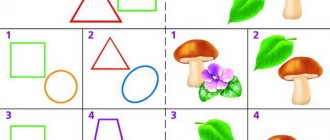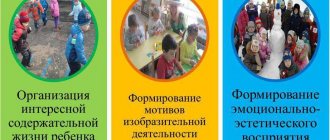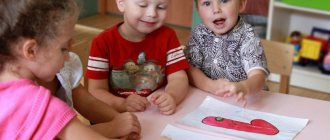In preschool age, all children love to draw; it helps them express themselves and comprehend the knowledge they have acquired about the world around them. That is why the development of creative abilities in visual arts is so effective and efficient.
For a long time, teaching drawing in childhood was considered almost exclusively as part of aesthetic education. However, at the end of the last century, psychologists finally recognized that visual activity is an important condition for the development of the child’s psyche, and not only creative abilities.
Children's development in visual arts
In the material you can see a selection of drawings by students of the author of the article, Marina Golubeva. Students made these images while doing the Draw a Sound activity. The results were very interesting drawings that illustrate how creativity and imagination come to life on paper.
Draw the sound - the sound of falling snow
The consciousness of preschool children, their thinking and worldview largely remain a mystery to teachers and psychologists. But studying the possibilities of developing creative abilities in visual activities led researchers to very interesting conclusions. It turns out that when a child is engaged in drawing, all mental processes are activated, including the development of creative thinking. But we are not talking only about this higher type of cognitive processes. The development of children in fine arts takes place in a variety of spheres and areas of the psyche.
- Drawing satisfies the most important needs of children: to communicate and understand the world, to express their emotions and relaxation.
- The development of fine motor skills of the hand in visual activities has a positive effect on all areas of the brain, activating thought processes.
- Development of visual memory: drawing not only ensures memorization and long-term preservation of images, but also stimulates their reproduction. Moreover, this happens directly, without connection with speech, which in children (and many adults) is not developed enough to convey all the details and nuances of visual images.
- The development of creative abilities in visual activity is also associated with the fact that drawing develops the skills of conscious, purposeful imagination.
- In preschool age, imaginative thinking plays an important role, and nothing develops it better than drawing.
Development of creativity in drawing – Call
The development of creative abilities in fine arts is not the only thing that determines the role of drawing in children’s lives. No less important is the fact that drawing has a huge psychotherapeutic effect. It helps kids relieve emotional stress, throw out negative emotions on paper, calm down and tune in to the positive.
Development of creative abilities of preschool children in fine art activities in accordance with the Federal State Educational Standard
Olga Lukina
Development of creative abilities of preschool children in fine art activities in accordance with the Federal State Educational Standard
«Federal State Educational Standards for Preschool Education development of creative abilities of preschool children in fine art activities»
“Drawing contributes to the diversified development of a child’s personality ”
Aristotle
Creative abilities are individual characteristics of a person’s qualities that determine the success of his performance of various types of creative activities .
The formation of a creative personality is one of the important tasks of pedagogical theory and practice at the present stage. Solving it should begin already in preschool age . The most effective means of achieving this is children's visual activity .
One of the objectives of the educational field is “Artistic and aesthetic development ”
in
the Federal State Educational Standard for Educational Education is the implementation of independent creative activities of children (visual, constructive-model, musical, etc.)
.
The implementation of the curriculum for the artistic and aesthetic development of preschool children requires teachers to constantly improve their pedagogical skills. A systematizing method in artistic and aesthetic activity is to distinguish three main types of artistic activity for visual spatial arts: fine, decorative and constructive. The development of creative abilities is carried out in drawing, modeling, appliqué, and design.
Visual activity is the most important means of artistic and aesthetic development , as well as a specific children’s activity aimed at the aesthetic development of the world through fine art, the most accessible form of a child’s knowledge of the world.
Visual activity is one of the most favorite activities for children in preschool age .
Art activities , observation, artistic, visual-figurative and verbal-logical thinking and memory of children, the ability to aesthetically perceive the world around them and convey it in drawings. Drawing classes in kindergarten can and should become a meeting with the beautiful: nature, man , the world of art. In order for children to feel beauty, it is necessary to turn the activity into admiration and involve all the senses.
The more senses are involved in the perception of the surrounding world, the more complete the ideas and the deeper the knowledge.
In the process of all types of visual activities (drawing, sculpting, appliqué)
the child experiences a variety of feelings. But the most important thing is that by creating an image, a child not only acquires various knowledge and skills, but also his value attitude to the world, to the social and cultural environment around him, to his individuality is formed, and his aesthetic perception of the world deepens.
Each child, when creating an image of a particular object, conveys the plot, includes his feelings, and understanding of how it should look. This is the essence of children's visual creativity , which manifests itself not only when the child independently comes up with the theme of his drawing, modeling, appliqué, but also when he creates an image on the instructions of the teacher, determining the composition, color scheme and other means of expression, making interesting additions .
Developing the creative abilities of a preschooler is the task of an adult.
The use of new forms of organizing visual activities is aimed at developing creative abilities and solves the following problems:
activity algorithm for children (using the example of visual activities )
;
• development of basic mental processes; satisfying the child's need for productive creative project activities ;
• formation and improvement of technical skills; developing the ability to use various means of expression and product design;
• development of the emotional sphere.
All forms of organizing visual activities require the active use of modern audiovisual teaching aids and new information technologies. Work in this direction is implemented, first of all, through educational work with parents, creating a subject-spatial environment in accordance with the requirements of the project method.
for children’s visual activities :
• organization of a subject-development environment ;
• creating a situation of success;
• combination of individual and collective types of work;
• building a game plot during the lesson;
• creating a situation of creative search ;
• stimulating children's creativity with entertaining content;
• use of various artistic materials and techniques;
• availability of creative tasks ;
• conducting observations before drawing from life;
• integration of various types of art;
• ensuring a positive family attitude towards the child's creativity .
To develop children's creativity, the following teaching methods can be used:
1) information-receptive method, which includes techniques for examining and showing a teacher’s model;
2) reproductive method aimed at consolidating the knowledge and skills of children. This is a method of exercise that brings skills to automaticity. It includes the technique of repetition, working on drafts, performing form-building movements with the hand;
3) a heuristic method, which is aimed at demonstrating independence at some point in the work during the lesson, i.e. the teacher invites the child to complete part of the work independently;
4) a research method that develops in children not only independence, but also imagination and creativity . The teacher offers to do not just any part, but all the work independently.
But, it should be noted that in many respects the result of a child’s work depends on his interest, so during the lesson it is important to intensify the preschooler’s and encourage him to activity with the help of additional incentives. Such incentives can be:
- play, which is the main activity of children ;
- a surprise moment - a favorite fairy tale or cartoon character comes to visit and invites the child to go on a trip;
- a request for help, because children will never refuse to help the weak, it is important for them to feel significant;
- lively, emotional speech of the teacher.
The child needs to be helped to learn different ways of drawing , to be given an understanding of different image techniques. Each of these techniques is a little game.
Their use allows children to feel more relaxed, bolder, more spontaneous, develops imagination , and gives complete freedom for self-expression.
Thus, I would like to say that in order to organize visual activities in a preschool educational institution, it is necessary to fulfill special conditions, use a variety of methods and techniques and forms of work.
The creative process is a real miracle - children reveal their unique abilities and experience the joy that creation brings them. Creative abilities develop when all conditions are created for this and are used to their full extent.
Each child's work is individual and unique.
Development of children's creative abilities through unconventional drawing
All children are researchers; they are passionate about learning previously unknown things and mastering new activities. Therefore, it is useful to use unusual techniques and develop children’s creative abilities through unconventional drawing.
Imagination on paper - clicking heels
The use of unconventional techniques and techniques helps children overcome fear and uncertainty, because they are still poor at using a pencil and brush, and they do not always like their own drawings. And failures greatly reduce motivation and interest in drawing and make it difficult to develop creative abilities in visual arts.
There are quite a lot of methods that are considered non-traditional, and they are intended for children of different ages. So, for the little ones the following are suitable:
- Finger painting is very useful in early childhood, as it develops not only imaginative thinking, but also tactile sensitivity.
- Finishing the drawing of handprints is very exciting and develops imagination and imaginative thinking.
- Using a variety of prints, which allows kids to admire the beautiful prints.
- Blotography is an absolutely amazing technique. Children love her very much, looking with delight at the original paintings created from simple blots.
- Drawing with sand allows kids to master a completely unusual material.
How to depict Rustle - draw the sound
MAGAZINE Preschooler.RF
Formation of artistic and creative abilities of children through visual activities (modeling)With the introduction of the Federal State Educational Standard for Education, the problem of giftedness is becoming increasingly relevant. This is, first of all, due to society’s need for an extraordinary creative personality. The recent growth in the volume of information requires changes in approaches to the content and conditions of educational activities.
The ability to think creatively, to see the problems of the world around us outside the box, is very important for a person, therefore, the disclosure of his creative abilities is the leading goal of education and upbringing.
Our century has opened up the opportunity to create in all areas of human activity. Moreover, novelty became the main criterion for creativity.
Children's creativity is a natural component of their development. At preschool age, a child discovers and reveals many possibilities for creativity, and easily creates one version of a creative product after another.
Every child has a need for creative activity: the child is looking for an opportunity to realize his potential; through creativity he can most fully reveal himself as a person.
Creativity for a child is more a process than a result. During this process, he better expands his experience, enjoys communication, and begins to trust himself more.
Pedagogical practice has a whole range of innovative methods and means for the development of a creative PERSONALITY.
The most effective means of achieving the development of creative abilities and independence are non-traditional types of visual activities for children.
An unconventional approach to creating images gives impetus to the development of children's intellect, encourages the child's creative activity, and teaches him to think outside the box. New ideas arise related to combinations of different materials, the child begins to experiment and create.
According to the requirements of the Federal State Educational Standard, one of the conditions for the development of a creative personality is the opportunity for children to choose materials, types of activities, participants in joint activities and communication; supporting children's initiative and independence. I try to realize all this through this type of fine art, such as modeling.
Modeling is one of the types of fine arts in which three-dimensional (sometimes relief) images and entire compositions are created from plastic materials. The three-dimensionality and three-dimensionality of the image gives enormous scope for imagination, the embodiment of creative thoughts and the development of imagination.
Modeling from various plastic materials is a fascinating, fascinating activity. This is a huge opportunity for children to think, try, search, experiment with materials, and most importantly, express themselves.
It is traditionally believed that the best material for modeling in kindergarten is clay. Unfortunately, recently this material has rarely been used for working with children. Objects made from it dry quickly and can be painted or painted. The main thing is that the clay is one color and when working with it, the child directs his main attention to creating an image, molding the shape of the object as a whole. Children sculpt from clay with greater consistency and pay more attention to the transformation of a piece of plastic material into a finished object than from colored plasticine. The skills learned by sculpting with clay can be easily transferred to sculpting with other materials.
Plasticine is one of the most affordable and easy-to-use materials for modeling. However, one of the disadvantages of working with plasticine is that it must be kneaded before starting work. The hand gets tired from such work, and fine work with the fingers becomes difficult. Therefore, it is advisable to take modeling from plasticine closer to the older group. Difficulty can also be caused by the fact that modeling from colored plasticine is carried out mainly by joining techniques, attaching small colored pieces to each other. When modeling in this way, the child loses sight of the overall shape of the object. But, despite the listed difficulties in working with plasticine, it is this material that allows you to approach the work most creatively.
Modeling from non-traditional plastic materials of your own making (like salt dough or paper pulp) is a real flame of creativity, it is an impetus for the development of imagination, the manifestation of independence, initiative, and expression of individuality.
In accordance with the Federal State Educational Standard for Education, the main model for organizing the educational process is the joint activity of an adult and a child.
In modeling classes I assume joint creativity between an adult and a child. In order to interest the children, I play out the situation, showing them how to operate with plastic materials. Once children have developed basic skills in working with plastic materials, they have more opportunities to work independently. This allows children to have some freedom of choice when making crafts. The child himself chooses what color the plasticine flower will be or where the plasticine snowflake will be located. This approach allows you to develop children’s imagination and their creativity (creative beginning of the individual).
And, of course, it is very important to emotionally charge children and turn the activity into an exciting game. We carefully examine the finished works, and I praise the little author for his efforts. I try to be attentive and conscious about the future fate of children’s works. It is very important that children feel respect for their creations. We must not forget that children need the constant attention of a significant adult, his praise and approval. The expectation of such attention is one of the most powerful psychological motives that encourage children to act and achieve results.
That’s why I organize exhibitions of children’s works and update them regularly. I often praise children, and I am not afraid to overpraise them. After all, such an attitude today will allow them to feel competent and confident people in the future.
The path to creativity has many roads, known and still unknown. Creativity for children is a reflection of mental work. Feelings, mind, eyes and hands are the instruments of the soul. The creative process is a real miracle.
The emphasis is shifted to the education of a truly free personality, the formation in children of the ability to think independently, acquire and apply knowledge, carefully consider decisions made and clearly plan their actions, and be open to new contacts.
| Next > |



